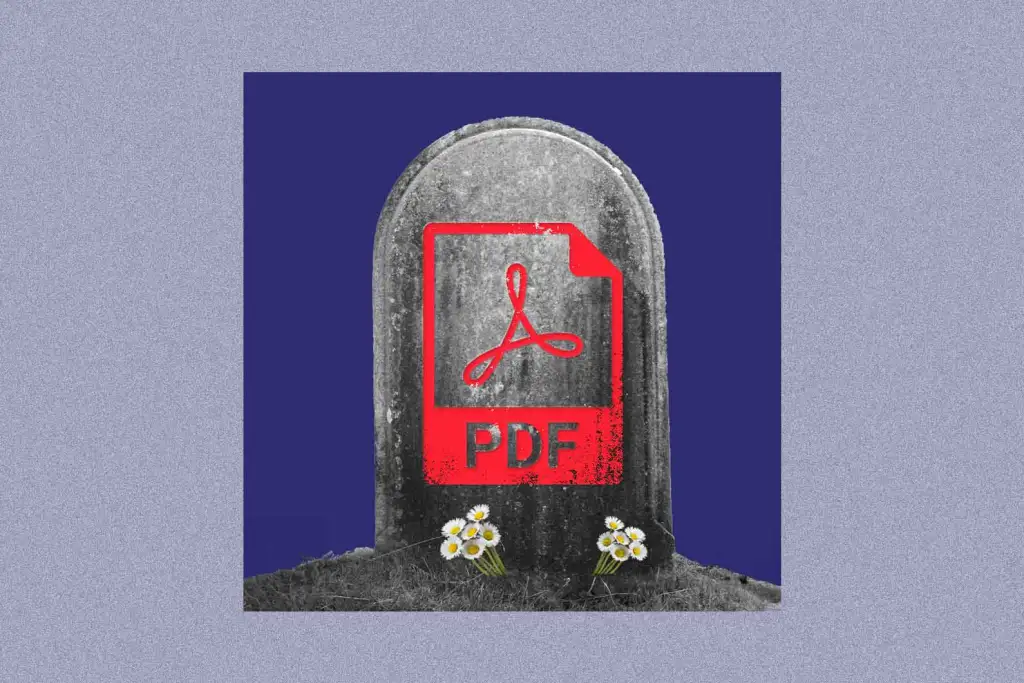
Ah, PDFs. The cockroach of digital content—just when we think we’ve found something better, they come crawling back into our lives, immune to all efforts to kill them off completely. Despite our frustrations, let’s face it: PDFs aren’t going anywhere. But we can all agree it’s time to stop treating them like the holy grail of digital content. Instead, we should think of PDFs as a last resort, a reluctant fallback, or a “necessary evil” (that could at least try to be a little friendlier).
So let’s dive into why we need a major re-think on PDFs and how to create better, more accessible alternatives that don’t force our users into the endless cycle of downloads, pinch-zooming, and broken links.
Why Do We Keep Using PDFs?
Honestly, it’s understandable. PDFs are easy to produce and a go-to for anything from complex reports to simple forms. You can slap them up on a site in minutes.
Done, right? Not so fast. This approach is doing your audience no favors.
- Terrible Accessibility: Most PDFs are a disaster for people with disabilities. They’re notorious for being non-compliant with screen readers, and if they’re not designed properly, they’re just about as user-friendly as a brick wall. Making them accessible is possible, but the hoops you’ll need to jump through are enough to make anyone question their life choices.
- Zero Mobile Friendliness: If you’ve ever tried to read a PDF on your phone, you know the struggle. Pinch. Zoom. Scroll left. Scroll right. Rinse. Repeat. It’s a workout, not a reading experience, and it’s definitely not what users expect in a mobile-first world. PDFs are static by nature, making them about as responsive as a rock.
- The SEO Black Hole: PDFs are where good content goes to die. Search engines aren’t fans of PDFs, and neither is your audience when they’re looking for specific information. The invisible text, missing metadata, and lack of headers pretty much guarantee your beautifully crafted PDF will remain in SEO purgatory.
- Impossible to Keep Updated: Every time you make a single update, you have to re-upload the whole document, often breaking links in the process. Users end up with five versions of the same document (all dated from last year), and heaven help anyone trying to find the latest version.
What We Should Be Doing Instead
So, what’s the alternative? We’re not saying no PDFs ever (I’m not that crazy), but let’s be strategic. Most content works better as HTML—web pages that are responsive, accessible, and indexed by Google. And when we do need a PDF? Let’s make sure it’s doing its best to play nice with our users.
- Accessible HTML Pages: For most content, skip the PDF and create a page that’s accessible, searchable, and way easier for your audience to read. HTML is responsive by nature, plays well with search engines, and it’s far easier to update on the fly without breaking links left and right.
- SEO-Boosted Content: HTML content is like a gift to Google, with metadata, tags, and all those juicy bits that help people find what they’re looking for. Think of it as giving your content a shot at digital fame, rather than leaving it to wither in PDF obscurity.
- Convert Key PDFs to Web-Friendly Resources: Not all PDFs are created equal, and some just make more sense as web pages. Try starting with your high-traffic or high-importance PDFs—guides, resources, forms—and convert them to web content. Not only does this create a better experience for your users, but you’ll thank yourself when updates are a matter of minutes, not re-uploads.
- Educate Your Team (and Maybe Yourself): Old habits die hard, especially when it comes to PDFs. So take some time to rally the team, and get everyone on board with accessible, responsive web content. The less people default to PDFs, the happier your users will be.
Let AI Take a Stab at Making Your PDFs SEO-Friendly
Here’s the deal: PDFs and SEO go together about as well as oil and water. PDFs are notoriously opaque to search engines, hiding all that valuable content in what basically amounts to a digital dead end. But thanks to advancements in AI, there are now tools that can help make your PDFs a bit less invisible.
Think of AI as a personal assistant on a mission to make your content more findable, scouring your PDFs for text and metadata that might otherwise be lost to the SEO abyss. Here’s what AI can do to save your PDFs from a life in digital obscurity:
- Automatic Metadata Extraction: AI tools can extract relevant keywords and create metadata, which is practically a lifesaver for making your PDF a little more search engine-friendly. Instead of having a PDF that’s just “Document123.pdf” in the eyes of Google, AI can pull out titles, descriptions, and keywords, so at least you’re giving search engines a fighting chance.
- Text Recognition for Image-Based PDFs: Let’s say your PDF is just a big ol’ image masquerading as a document (we’ve all been there). AI can perform optical character recognition (OCR) on image-based PDFs, making the text searchable and crawlable. In other words, it turns a brick wall of an image into actual text that Google can see.
- Intelligent Tagging and Structure: AI can add tags and headings within the document structure, which might sound like a snooze, but it’s a big deal for SEO. This helps search engines identify the hierarchy and relevance of the content within your PDF, which means more search visibility.
- Optimizing Content Placement for Keywords: AI can even analyze keyword placement within your document and make suggestions to improve it. This is like having a digital copy editor whispering in your ear: “Maybe put that keyword a little closer to the top next time.” It’s not magic, but it’s a whole lot better than nothing.
So, while AI isn’t going to make your PDFs sing and dance on the SEO stage, it can at least give them a shot at being noticed. But let’s be real: the best way to ensure content visibility is still to put it on a nice, clean HTML page. Use AI as a last resort when PDFs are absolutely unavoidable, but if you can convert that content to web-friendly HTML, do it and thank yourself later.
A World Where PDFs Aren’t the Star of the Show
Look, we get it. PDFs aren’t vanishing any time soon. But that doesn’t mean we need to keep inflicting them on our users at every turn. Embracing a more thoughtful, user-focused approach to content means we can have the occasional PDF without letting them run the show. And when PDFs are necessary? Let’s at least make them accessible and optimized for today’s standards.
It’s time to let PDFs retire from the spotlight. Treat them like the necessary evil they are, and do right by your audience with content that’s accessible, mobile-friendly, and just plain easier to use. The result? Happier users, more visibility for your content, and a digital experience that’s as modern as it should be.






